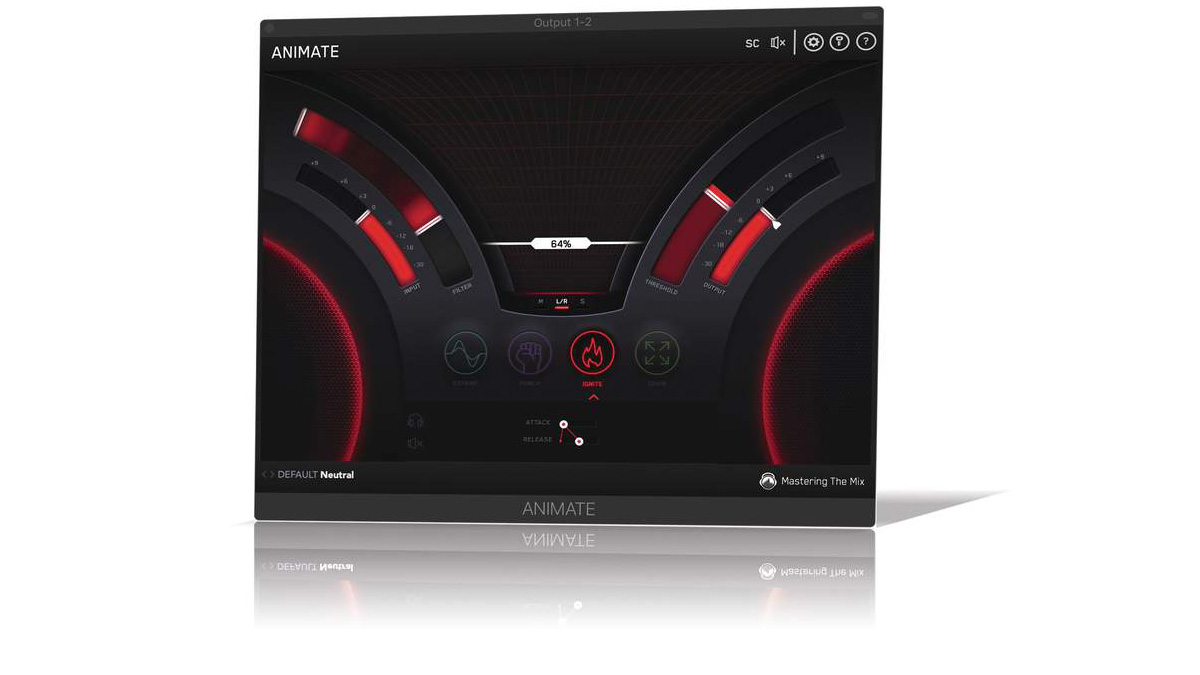MusicRadar Verdict
Dynamic enhancement, polishing, beefing up, embiggening and more are all on the cards with this eye-popping plugin gem.
Pros
- +
Four high-quality, focused effects.
- +
Simple control set is very easy to use.
- +
Sidechain input for Threshold control.
- +
We like the price!
Cons
- -
There’s no real reason all four modules couldn’t be viewed together.
- -
Silly slide-up panel has got to go.
MusicRadar's got your back
Animate is a plugin effect (VST/AU/AAX) that applies four independent modules - Expand (expansion), Punch (transient enhancement), Ignite (distortion) and Grow (stereo widening) - to individual tracks, busses and full mixes.
Switching the interface between them is done using the four central buttons, and the modules are colour-coded for easy identification. Each button is grey until the amount slider for its module is raised above 0%, whereupon it takes on the relevant colour, although that’s the only information you get for the three unselected modules - there’s no indication of mute status, which needs addressing. The output slider, despite being global, also changes colour, which feels kind of weird - it really doesn’t need to.
Motion capture
Each Animate module can be set to process the Mid, Side or L/R stereo signal (so two instances if you want to affect both Mid and Side). To apply a module to the full frequency range, select it, pull down its Threshold slider to set the level that has to be exceeded before the effect kicks in, then raise the main Amount slider - this sets the dry/wet mix up to 100% wet, then boosts the wet signal gain up to 300%. To target the module at a specific frequency band, adjust the 24dB/octave high- and low-pass filter sliders - the track along which they slide helpfully shows the energy distribution across the spectrum as a ‘heatmap’, aiding greatly with placement. Modules can be muted and soloed, boosted or attenuated at their inputs, and (a little) more - see Hidden treasure below.
At the bottom of the Animate interface are a small series of contextual controls for tweaking the response of each module. These can be hidden behind a slide-up panel if you don’t want to see them - not only is this totally pointless, but it’s all too easy to accidentally close said panel while aiming for the mute or solo buttons. Annoying...
Common to all four modules are their Attack/Release envelopes, setting the onset time of each effect after the Threshold is exceeded, and how long it takes to ‘let go’ when the input signal drops back below it again. The Attack stage ranges from 1-100ms, while the Release covers 1-300ms.
Alongside the envelope, the rest of the controls consist of Knee (Hard to Soft - 1-20dB) and Ratio (1:1-1:4) for Expand, Sensitivity for Punch (determining how hefty a transient needs to be for detection), and Width for Grow (the delay between left and right, ranging from -30 to 30ms).
The Level Match pointer on the Output slider moves to show the level that needs to be set to match output to input - click it to snap the slider to that point. It’s a clever system, but an automatic mode would be welcome, alleviating the need to click the pointer after every gain- changing edit.
The all-important modules themselves are great. Expand applies transparent upward expansion at ratios up to 1:4, while Punch does a superb job of subtly emphasising transients or aggressively sharpening them up. Ignite delivers truly delicious harmonic distortion, drivable into decimation if required, and Grow is ideal for dynamically widening mono sources and spreading out stereo ones.
Prime mover
Animate is one of those plugins that needs to be handled with care, as small parameter changes can often lead to big sonic effects. That’s not a criticism; just something to be aware of.
Ultimately, while the algorithms behind each module sound excellent, it’s the adjustable dynamic and frequency-based response that defines Animate. The ability to hit only the loudest parts of a mix in a certain frequency range with transient boosting or distortion, say, opens up all sorts of creative mixing avenues.
We don’t see why the interface needs to be ‘modal’, however. There are few enough controls that all four modules could easily be shown together in a larger UI, which would only be a good thing. The graphics are nice n’ all, but it’s a clear case of design for design’s sake, at the expense of practicality. Even in its histrionic, mildly fiddly current form, though, this is a powerful, creative and endlessly useful plugin at a thoroughly fair price.
Computer Music magazine is the world’s best selling publication dedicated solely to making great music with your Mac or PC computer. Each issue it brings its lucky readers the best in cutting-edge tutorials, need-to-know, expert software reviews and even all the tools you actually need to make great music today, courtesy of our legendary CM Plugin Suite.
“Built from the same sacred stash of NOS silicon transistors and germanium diodes, giving it the soul – and snarl – of the original”: An octave-fuzz cult classic returns as Jam Pedals resurrects the Octaurus
What’s the buzz? Meet Yellowjacket, Cherry Audio's recreation of EDP’s trend-setting Wasp from 1978
“A fabulous trip through all eight songs by 24 wonderful artists and remixers... way beyond anything I could have hoped for”: Robert Smith announces new Cure remix album











